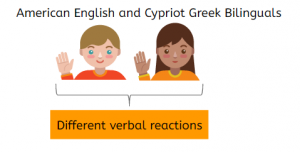Contents
Cross-linguistics influences on SLA
Overview
In this blog, we examine ways in relation to how cross-linguistics aspects influence one’s ability in acquiring a second language. We will be referencing data obtained from three various studies which focus on L2 acquisition in children, the use of L2 English (in literature) as well as the effect of cultural influences on emotional perceptions.
Introduction
Do you know that the processes of second language acquisition has always been a topic of discussion among many, due to its importance in today’s globalized society? A greater percentage of the world population is bilingual compared to monolingual (Linguistic Society of America, 2012). In today’s context, it is the norm for people to speak 2 or more languages. However, not everyone is equally proficient in the several languages they speak. It is highly likely that a significant number would have one language in which they are the most proficient in, and slightly lower competency for the rest of their languages. In this case, cross-linguistics influences will come into play. For those who wish to gain a greater proficiency in more than one language, cross-linguistics influences play an important role in the journey to acquire a second language.
Factors
Cross-linguistic influences on syntax & discourse in children
The first study we have chosen examines how the properties of the first language (L1) and second language (L2) is supplemented and meshed with one another in the process of L2 acquisition in a child.  According to Müller and Hulk’s (2001) account, for cross-linguistic influence to occur at the level of syntax-discourse, two conditions need to be met.
According to Müller and Hulk’s (2001) account, for cross-linguistic influence to occur at the level of syntax-discourse, two conditions need to be met.
- Cross-linguistic influence should occur at the intersection of the two language systems, between the syntax and discourse.
- There is a need for the presence of a surface structural overlap; some similarities in the structure of the two languages.
If the surface structure of language A allows two possible analyses while language B offers strong support for one of the two analyses available in language A, then cross-linguistic influence is predicted to happen from language B to language A. This cross-linguistic influence will surface as delay in the acquisition of this phenomenon in language A.
Recent acquisition studies have supported that interfaces are relatively vulnerable in language acquisition. The Interface Hypothesis (IH) proposed by Sorace and Filiaci (2006) and Sorace (2011) assumes that different interfaces pose different levels of difficulties in learning L2 properties.
It predicts that
Properties which involve the semantics & syntax (internal interfaces) of language can be acquired more easily compared to those that involve the external interface, which are the cognitive domains.
Instability at the interface is due to the processing constraints imposed.
Acquisitional process of L2 may be slowed down due to the fact that the learner has to integrate multiple informations at once, from multiple domains, which may limit his/her processing abilities.
If the vulnerability lies at the knowledge level, we expect L2 children who have not fully developed this interface in their L1 to show a delay in the acquisition of this interface in their L2. If L2 children have acquired knowledge of the properties regulating this interface in their L1, the acquisition of their L2 would definitely be more advanced and be fast-forwarded (Paradis & Genesee, 1996), especially if there is an overlap in the syntax-discourse properties of their L1 and L2. An accelerated speed in L2 acquisition may arise from a greater familiarity of their L1. However, it is important to note that children are cognitively less mature and have fewer processing capabilities compared to adults, therefore limitations in information-processing might be highlighted.
The various language-specific properties of target languages can result in either similar or distinct developmental paths: Turkish-speaking children in the Netherlands and the UK acquiring L2 Dutch and L2 English definite articles respectively followed the same developmental patterns, due to the similarities of the semantic properties of the definite article systems in Dutch and in English. Both English and Dutch are head first languages, where the determiners (and/or prepositions) are the head of phrases. This shows that similarities in semantic properties of the native language and target language to be acquired, will result in accelerated acquisition of the L2.
However, the study of cross-linguistic effects in successive childhood bilingualism is a complex task because of the different directions that cross-linguistic influence can take. Cross-linguistic influence can be affected by factors internal to the language system being acquired, as mentioned above, as well as by language-external factors, such as the length and context of exposure to the L2.
Cross-linguistics influences on English literature
 There are two factors leading to spurt in English writing. The first factor is the growth in bilingualism in English, creating sizable numbers of English-knowing indigenous people who could be counted on as a potential audience for the new literature (see, e.g., Fishman et al. 1978; Reddy 1979). The second factor may be referred to as the increasing confidence with which non-native writers came to handle the language in registers other than the legal and administrative.
There are two factors leading to spurt in English writing. The first factor is the growth in bilingualism in English, creating sizable numbers of English-knowing indigenous people who could be counted on as a potential audience for the new literature (see, e.g., Fishman et al. 1978; Reddy 1979). The second factor may be referred to as the increasing confidence with which non-native writers came to handle the language in registers other than the legal and administrative.
This article seeks to analyse some linguistic and literary processes employed to extend the potential of the English language to express alien meanings; the difficulty of non-native English literature (NNEL) and its relevance to native and non-native speakers of English. English is considered the primary language of expression in this case. Due to their educational training, some people feel more at home in English than in their mother tongue. Although some are bilingual writers (A. K. Ramanujan writes in both English and Kannada, and Chinua Achebe writes in English and Igbo), the majority of the authors write only in English.
Nativization of English in NNELs has been done for vocabulary, collocation, idiomaticization, syntax, rhetorical patterning as well as the adaptation of Western English literary forms to express the L2 writers’ individual thoughts and feelings which are not native in their L1 speech community.
There are several problems in the usage of non-native English in literatures.
- Nomenclature, which is the finding of words for culturally bound everyday objects. Most of the time, authors end up resorting to borrowing with the inclusion of glosses or “contextualising” the new item by embedding it in a passage that makes the meaning of the term self-explanatory.
- Conveying nodes of feeling and thinking unique to the writer’s cultural context. In Kannada and Tamil, they use questions without inversions such as “And you’ll allow me to speak?” or “Brother, you are with me?”. However, in English, we invert the subject and the verb, with an auxiliary or modal verb before the subject for example, “Are you with me?”.
- Difficulty in translation if there is a lack of transparency (eg. dining leaf and idiomatic expressions). Such is when the translations lack the affective associations of the original semantics.
- Distorted expression like guest-host interaction can also occur. In this translated Indian expression of “Take only this much milk, aunt, just this much”, which has the same meaning as “’Won’t you have a second helping?” in English, the Indian phrases can be considered to be more discourteous when read by non-Tamil speakers who have not been exposed to such cultures.
 Indian writers, for example, like to implement cultural aspects in their writings. The use, misuse and non-use of proverbs helps to differentiate characters. One such example would be the abuse of proverbs by a character through the distortion of meaning, which is considered an effective device to convey the character’s flouting of traditional values. In light of cultural-specific materials, cultural and literary background might be needed to fully comprehend literature written by non-native English speaker who makes reference to his/her (L1) culture. (There can be multiple interpretations in poetry and not just one definite answer, which would mean that the above-mentioned cultural and literary background might not necessarily be needed. However, if one wishes to engage in serious literary criticism, it is essential for one to be equipped with knowledge of the author’s cultural and literary traditions.)
Indian writers, for example, like to implement cultural aspects in their writings. The use, misuse and non-use of proverbs helps to differentiate characters. One such example would be the abuse of proverbs by a character through the distortion of meaning, which is considered an effective device to convey the character’s flouting of traditional values. In light of cultural-specific materials, cultural and literary background might be needed to fully comprehend literature written by non-native English speaker who makes reference to his/her (L1) culture. (There can be multiple interpretations in poetry and not just one definite answer, which would mean that the above-mentioned cultural and literary background might not necessarily be needed. However, if one wishes to engage in serious literary criticism, it is essential for one to be equipped with knowledge of the author’s cultural and literary traditions.)
Cross-linguistics influences of L2 on L1
The study by Ożańska (2016) examines the emotion of ‘tęsknota’, which is a socio-culturally determined expression and experience unique to Polish scenarios. There are no simple monolexemic English equivalents to describe the original meaning accurately. The experiment intended to study on the effect of L2 culture immersion on the perception of L1 Polish speakers on ‘tęsknota’.
There were different views presented by various writers on language and emotion perceptions.
Rosaldo (1984): The immersion in the L2 culture will affect how speakers perceive this L1 culture-specific emotion.
Ekman (1973): Most of the common emotions, such as surprise, joy, sadness, anger and are more comprehensive to all language users.
 It has been pointed out that some emotions could be both culture- and language- specific, for example, Polish ‘tęsknota’, Russian ‘perezhivat’, Greek ‘stenahoria’, and Italian ‘fare festa a qualcuno’. Others have suggested that feelings could be both culture-specific and perceptible in all cultures.
It has been pointed out that some emotions could be both culture- and language- specific, for example, Polish ‘tęsknota’, Russian ‘perezhivat’, Greek ‘stenahoria’, and Italian ‘fare festa a qualcuno’. Others have suggested that feelings could be both culture-specific and perceptible in all cultures.
The duality of universality and specificity of emotions is the reason why speakers can identify common emotions across different cultures while having the ability to learn additional feelings when they are immersed in an environment with foreign language and culture. People who speak different languages might have different conceptual representations of emotions.
Socialisation or assimilation into a second language culture and language could play a vital part in the interplay of cultures and languages in the utterance and comprehension of emotions. It alters the emotionality of the second language, giving the L2 speaker a larger variation in freedom of expression but also the changes the perception of emotions of their original language.
Bilingualism and perception of emotions
Russian verbs were used as an example to demonstrate difficulties in learning specific emotions for English speaking L2 learners, mainly because of the lack of semantic equivalents in English. Similar meanings could be expressed in more narrow or broader terms in other languages. Learners would map the word onto a fragmented translation equivalent respective to another word of a similar meaning. Native Russian speakers could use the 2 words easily to describe the emotion compared to L2 learners who did not use them at all. Conceptual shifts were also observed where L2 learners combined change-of-state verbs and adjectives to illustrate these feelings as states, instead of processes which were expected in the Russian language.
 The forming of feelings and emotions in a bilingual and/or bi-cultural setting was also found to be different. When American English and Cypriot Greek bilinguals were presented with a scenario using different languages, their verbal reactions were different. The authors mentioned that the subjects switched their social code and socio-cultural presumptions when there is a change in linguistic code. These emotion concepts therefore hinges on the socio-cultural environment since they were learnt and picked up by systems of utterance and comprehension. Bilinguals will take on specific emotions as they pick up these socio-cultural implications which they convey in specific language systems, suggesting that a second language is capable of altering the use of such feelings in a speaker’s L1.
The forming of feelings and emotions in a bilingual and/or bi-cultural setting was also found to be different. When American English and Cypriot Greek bilinguals were presented with a scenario using different languages, their verbal reactions were different. The authors mentioned that the subjects switched their social code and socio-cultural presumptions when there is a change in linguistic code. These emotion concepts therefore hinges on the socio-cultural environment since they were learnt and picked up by systems of utterance and comprehension. Bilinguals will take on specific emotions as they pick up these socio-cultural implications which they convey in specific language systems, suggesting that a second language is capable of altering the use of such feelings in a speaker’s L1.
Comparing between Polish and English, both languages vary in how they encode emotions. Emotions are commonly expressed by verbs in Polish while English does the same in adjectives. This difference suggests that English speakers consider emotions as inner states and verbs refer to processes for them. The way speakers comprehend and express an emotion, through the outlook of different languages, holds possible influence on our linguistic behaviour.
Situation description task
 In a study carried out, two groups of Polish L2 users of English were used; one group consisting of participants who lived in Poland all their lives and the other consisting of participants who had experiences of residing abroad in an English-speaking country for more than half a year. Monolinguals comprising of native Polish and English speakers respectively, were also used in the pilot study. The emotion ‘tęsknota’ was then described in a short text for the different groups of participants and were requested to answer “what kind of emotion does X feel?”, subsequent to reading the story in English and Polish. The results for the control group which consist of Polish speakers who have never been overseas to an English-speaking country before was expected with 100% accuracy, suggesting that the knowledge of another language did not change how speakers view their culture specific emotion of ‘tęsknota’.
In a study carried out, two groups of Polish L2 users of English were used; one group consisting of participants who lived in Poland all their lives and the other consisting of participants who had experiences of residing abroad in an English-speaking country for more than half a year. Monolinguals comprising of native Polish and English speakers respectively, were also used in the pilot study. The emotion ‘tęsknota’ was then described in a short text for the different groups of participants and were requested to answer “what kind of emotion does X feel?”, subsequent to reading the story in English and Polish. The results for the control group which consist of Polish speakers who have never been overseas to an English-speaking country before was expected with 100% accuracy, suggesting that the knowledge of another language did not change how speakers view their culture specific emotion of ‘tęsknota’.
However, those participants who once lived in an English-speaking country, gave a different result, with only 81% of them given ‘tesknota’ as the answer, and there were other variations such as ‘loneliness’ and ‘nostalgia’. This shows that with the inclusion of socialisation in the L2 culture and language, there are could have impacts on how they perceive their L1 emotions. This is possibly caused by language dominance and undergoing assimilation in the L2.
Discussion
The emotions of a bilingual could be shaped by lexical and grammatical expressive devices of the first language to some extent. The emotion terms of L2 might not necessarily match those of the L1 or the speaker’s emotions, since they are most probably influenced by their first language.
Residence in an English-speaking country and inclusion of attempts to assimilate into the L2 culture and language could bring consequences on the view of L1 emotions. There is a high possibility that language dominance and affective assimilation into the L2 was taking place. While knowing a new language might not have a direct influence on the how speakers view their L1 emotions which are culturally determined, the combination of L2 knowledge and the frequency of naturalistic usage, especially in possible attempts of assimilation while living in an English-speaking country for quite some time, alters the comprehension of such emotions for speakers. This indicates that learning another language, coupled with the assimilation into a new environment can bring about an incorporation of other views on the emotion of L1.
This study has demonstrated that cross-linguistic influences are bi-directional, where a ‘reverse transfer’ can also occur, albeit not as commonly studied as the cross-linguistic influences of L1 on L2. L2 can possibly affect the L1 of an individual as well, where L2 properties may potentially affect L1 performance or even representations (‘L2-to-L1 effects’). L2-to-L1 effects have been studied in the context of near-native L2 adults with highly stable grammars acquiring syntax-discourse interface phenomena (Sorace, 2011 for an overview). These effects are expected because near-native L2 speakers have had extensive naturalistic L2 exposure, which by then would have exceeded L1 exposure and frequency of use.
Further research directions and applications
 Taking into account how the language system in the first language is highly likely to affect the rate of acquisition of the second language, teachers can make use of the similarity of the surface structures in the two languages in order to accelerate the learning of the second language in a student. However, that is only possible if the L2 being learnt has some degree of structural overlap with L1. Otherwise, teachers can just focus on various external factors like the length of exposure or relevant usage of the L2 in their teachings, in an attempt to speed up the learning process of L2.
Taking into account how the language system in the first language is highly likely to affect the rate of acquisition of the second language, teachers can make use of the similarity of the surface structures in the two languages in order to accelerate the learning of the second language in a student. However, that is only possible if the L2 being learnt has some degree of structural overlap with L1. Otherwise, teachers can just focus on various external factors like the length of exposure or relevant usage of the L2 in their teachings, in an attempt to speed up the learning process of L2.
 Additionally, literature in the second study is relevant to the teaching of English as a second language. The growth of non-native English literature provides a different and unique opportunity to study the nativization of English in different mother tongue groups, also enabling the comparison of the similarities and differences in the process of making the language more native-like (indigenization). The major motivation of non-native speakers in learning English is to “culturally identify and integrate oneself with the native English speech community”. Hence, it will be more effective to use literature that deals with the life that is familiar to them, instead of literature with profound meanings that requires a certain level of competency in that language to be able to fully comprehend it. Examples of profound meanings would be as follows: “April is the cruellest month breeding” and “Lilacs out of the dead land mixing”. There is a high chance that non-native speakers would be unable to comprehend the intended meaning of such phrases. Therefore, English teachers must teach the kind of English that is best suited for the needs of L2 speakers. For instance, the second article reviewed mentioned speakers in third world countries who use English as a tool to acquire scientific & technological skills. This would mean that it would be best for the English teachers of those with such intentions, to teach the type of English which revolves around science and technology, in addition to some basic communication skills.
Additionally, literature in the second study is relevant to the teaching of English as a second language. The growth of non-native English literature provides a different and unique opportunity to study the nativization of English in different mother tongue groups, also enabling the comparison of the similarities and differences in the process of making the language more native-like (indigenization). The major motivation of non-native speakers in learning English is to “culturally identify and integrate oneself with the native English speech community”. Hence, it will be more effective to use literature that deals with the life that is familiar to them, instead of literature with profound meanings that requires a certain level of competency in that language to be able to fully comprehend it. Examples of profound meanings would be as follows: “April is the cruellest month breeding” and “Lilacs out of the dead land mixing”. There is a high chance that non-native speakers would be unable to comprehend the intended meaning of such phrases. Therefore, English teachers must teach the kind of English that is best suited for the needs of L2 speakers. For instance, the second article reviewed mentioned speakers in third world countries who use English as a tool to acquire scientific & technological skills. This would mean that it would be best for the English teachers of those with such intentions, to teach the type of English which revolves around science and technology, in addition to some basic communication skills.
To add on, the study of cross linguistics influences and the interlanguage of L2 learners might have several implications for the EFL classroom where English is not the dominant language.
- Decision making with regards to curriculum planning and textbook selection should consider the kind of transfer that is involved between the L1 and L2 of a specific group of learners and what are the factors and reasons for its occurrence.
- To minimize negative attitudes towards L2 learners’ insertion of L1 word borrowings and the use of coinages in an attempt to fill a lexical gap in L2. They may have required the assistance from their L1 as positive attempts to achieve effective communication.
- Curricular activities could be planned to foster learners’ own judgement of language choices they make when communicating in L2 and the significance of these choices, in order to make the acquisition of L2 a less tedious task.
Conclusion
The processes of second language acquisition has become increasingly integrated with globalisation. Throughout the past few decades, tremendous progress has been made in gaining a better understanding of second language acquisition processes, as well as the cross-linguistics factors which might affect this process. The different languages we speak profoundly influence the way we think. Our findings suggest that a L2 learner’s syntax, writing style and emotion is shaped by his/her first language. The significance of SLA research for teaching is to raise awareness about the specificity of the classroom context for better and more efficient acquisition of a second language.
The factors of cross-linguistics influences play an important role in understanding the rate and progress of second language acquisition, which can then help enhance the efficiency in second language acquisition. With such an approach, people will be able to acquire a second language to a greater degree of success in an easier and more effective manner.
References
Chondrogianni, V., & Vasić, N. (2016, August). Cross-linguistic aspects in child L2 acquisition. International Journal of Bilingualism., 20(4), 361-368.
Ekman, P. (1973). Darwin and facial expression; a century of research in review. New York, NY: Academic Press.
Kachru, B. B. (1992). The Other tongue : English across cultures. Urbana : University of Illinois Press, 1992.
Linguistic Society of America (2012). Multilingualism. Retrieved from http://www.linguisticsociety.org/resource/multilingualism
Ożańska-Ponikwia, K. k. (2016). The influence of immersion in the L2 culture on perception of the L1 culture-specific emotion of tęsknota. International Journal Of Bilingualism, 20(2), 116-132. doi:10.1177/1367006914537728
Rosaldo, M. (1984). Toward an anthropology of self and feeling. In R. A. Shweder & R. A. LeVine (Eds.), Culture theory: Essays on mind, self, and emotion (pp. 137–157). Cambridge, UK: Cambridge University Press.